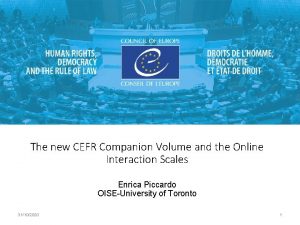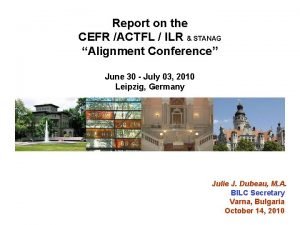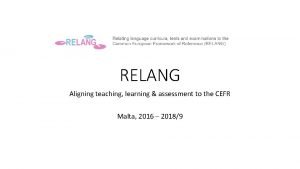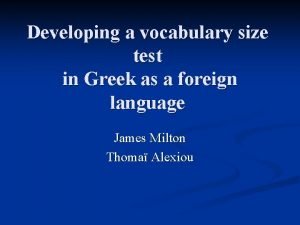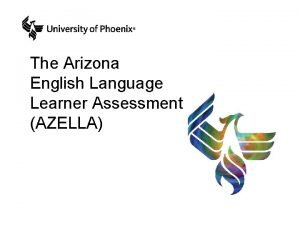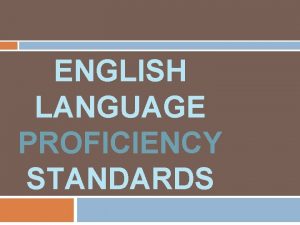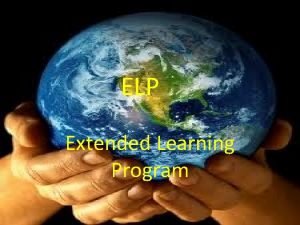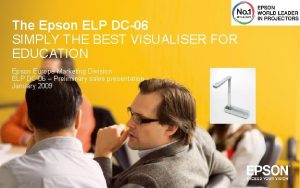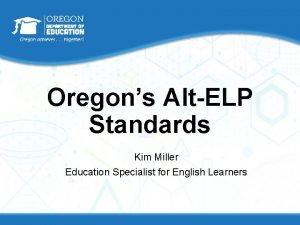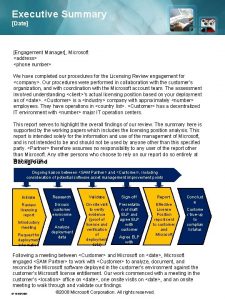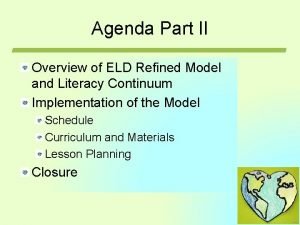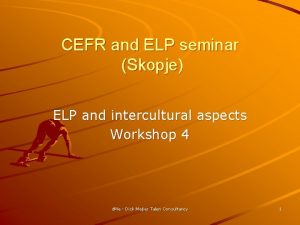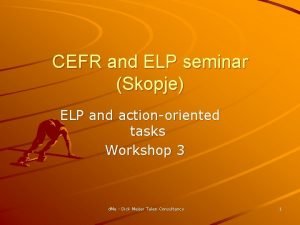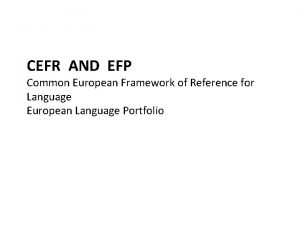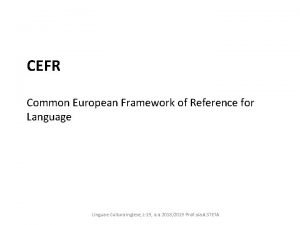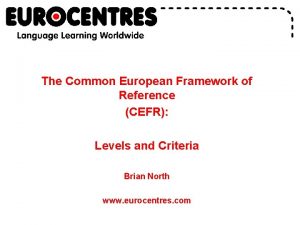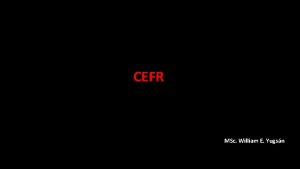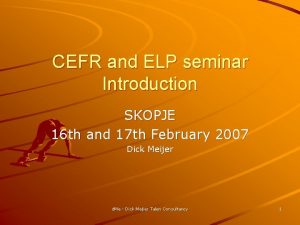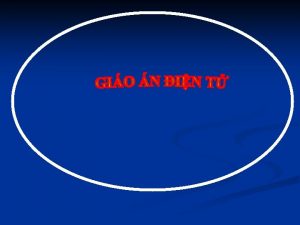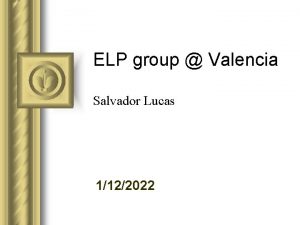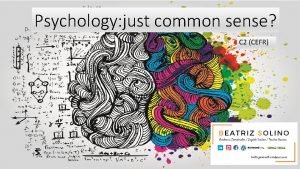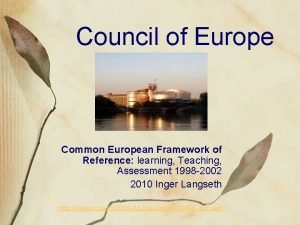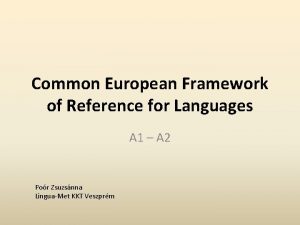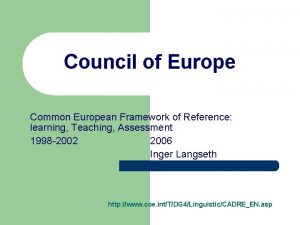CEFR AND ELP Common European Framework of Reference















- Slides: 15

CEFR AND ELP Common European Framework of Reference for Language European Language Portfolio

The CEFR: an overview • First published: 1991 • Purpose – To provide a way of comparing people’s ability in different languages (esp. the languages of the EC) • Main points – Focus on communicative ability – The identification of levels of linguistic competence (saper fare vs. sapere) – Integration of language and interpersonal skills (saper apprendere, saper essere)

CEFR levels • There are six levels, divided into three bands. • Elementary A 1, A 2 • Intermediate B 1, B 2 • Advanced C 1, C 2 • Each level has a “name” as well as a code – The name reflects the competence reached • A 1 breakthrough; A 2 waystage • B 1 threshold; B 2 vantage • C 1 effective operational proficiency; C 2 mastery

Listening Grade A 1 1 I can understand a few familiar spoken words and phrases A 1 2 I can understand a range of familiar spoken phrases A 1 3 I can understand the main point(s) from a short spoken passage A 2 4 I can understand the main points and some of the detail from a short spoken passage e. g. the teacher’s instructions, days of the week, colours or numbers e. g. basic phrases concerning myself, my family and school e. g. short rhyme /song, a phone message, announcement or weather forecast … e. g. sentences describing people, what they are wearing, what they are doing A 2 5 I can understand the main points and simple opinions (e. g. likes and dislikes) of a longer spoken passage e. g. children talking about their likes and dislikes; descriptions of people and what they are wearing A 2 6 I can understand spoken passages referring to past or future events e. g. someone giving details of what he or she did on holiday or at the weekend; a telephone conversation arranging to meet someone …

Speaking and talking to someone Grade A 1 1 I can say/repeat a few words and short simple phrases A 1 2 I can answer simple questions and give basic information A 1 3 I can ask and answer simple questions and talk about my interests A 2 4 I can take part in a simple conversation and I can express my opinions A 2 5 I can give a short prepared talk, on a topic of my choice, including expressing my opinions e. g. what the weather is like; greeting someone; naming classroom objects … e. g. about the weather; where I live; if I have brothers or sisters, or a pet … e. g. taking part in an interview about my area and interests; a survey on pets or favourite foods; talking with a friend about what we like to do and wear … e. g. discussing a picture with a partner, describing colours, shapes and saying whether I it or not; asking for /giving directions; discussing houses, pets, food … e. g. talking on a familiar subject; describing a picture; making a presentation … A 2 6 I can give a short prepared talk, on a topic of my choice expressing opinions and answering simple questions about it e. g. talking about school, asking/answering questions on sport or a story

Reading grade A 1 1 I can recognise and read out a few familiar words and phrases A 1 2 I can understand familiar written phrases A 1 3 I can understand the main point(s) from a short written passage in clear printed script e. g. from stories and rhymes, labels on familiar objects, the date, the weather e. g. simple phrases, weather phrases, simple description of objects, someone writing about their pet … e. g. very simple messages on a postcard or in an e-mail … A 2 4 I can understand the main points and some of the detail from a short written passage e. g. three to four sentences of information about my e-pal; a description of someone’s school day … A 2 5 I can understand the main points and simple opinions (likes and dislikes) of a longer written passage e. g. a postcard or letter from a penpal; a written account of school life, a poem or part of a story … A 2 6 I can understand longer passages and distinguish present and past or future events e. g. a short story; a description of someone’s day; a letter in which someone describes a person or place, an excursion

Writing grade A 1 1 I can write or copy simple words or symbols A 1 2 I can write 1 -2 short sentences and fill in the words on a simple form A 1 3 I can write two to three short sentences using reference materials/with the support of a peer e. g. personal information, where I live, how old I am, numbers, colours and objects … e. g. a shopping list, holiday greetings by e-mail or on a postcard … e. g. a postcard, a simple note or message, an identity card … A 2 4 I can write a short passage on a familiar topic using reference materials/with the support of a peer e. g. 3 -4 sentences for a wall display; a simple e-mail message … A 2 5 I can write a short passage on a range of everyday topics A 2 6 I can write a simple text, e. g. a letter, giving and seeking information e. g. 3 -4 sentences about myself, about a story and about a picture; a message containing three to four sentences; a postcard or greetings card … e. g. about holidays, hobbies, outings, where I live …


ELP – fast facts • The European Language Portfolio… – has three components: • a language passport • a language biography • a dossier of language work – belongs to the learner • the learner is the “owner” of the portfolio – has a reporting function and a pedagogical function. – contributes to the development of learner autonomy – encourages life-long learning






 Ielts levels
Ielts levels Cefr levels toefl
Cefr levels toefl Cefr level english
Cefr level english Reception production interaction mediation
Reception production interaction mediation Content communicative achievement organisation language
Content communicative achievement organisation language Actfl to ilr
Actfl to ilr Language
Language Cefr analyzer
Cefr analyzer Cefr vocabulary size
Cefr vocabulary size Arizona elp standards
Arizona elp standards English language proficiency (elp) standards scavenger hunt
English language proficiency (elp) standards scavenger hunt Elp class
Elp class Best visualiser
Best visualiser Language proficiency
Language proficiency Effective license position microsoft
Effective license position microsoft Elp standards az
Elp standards az



